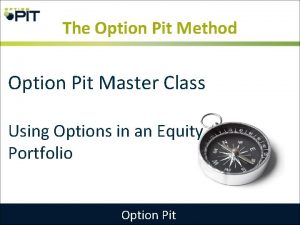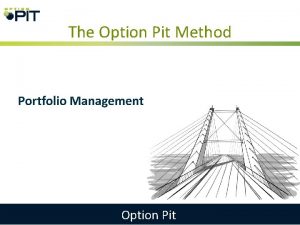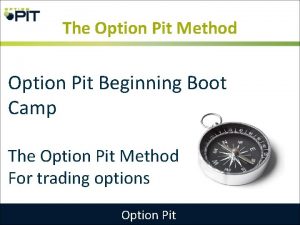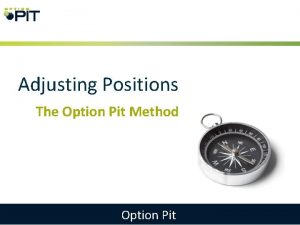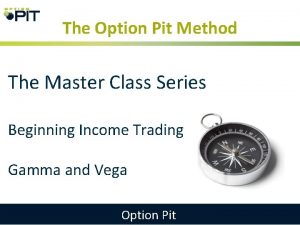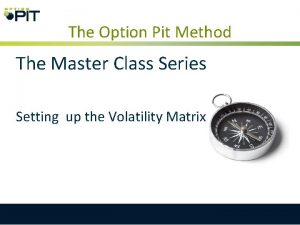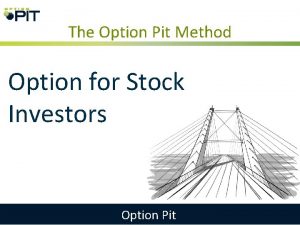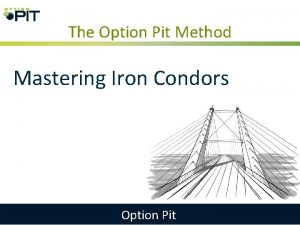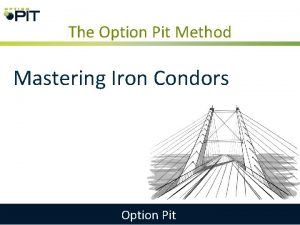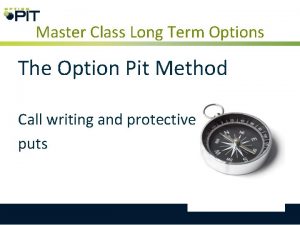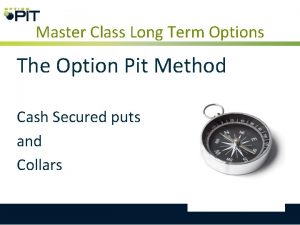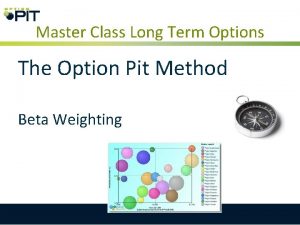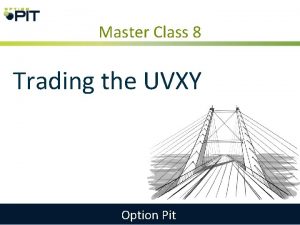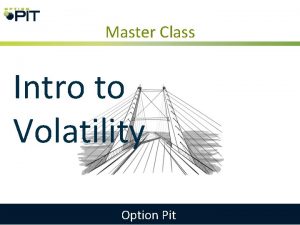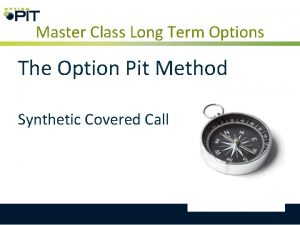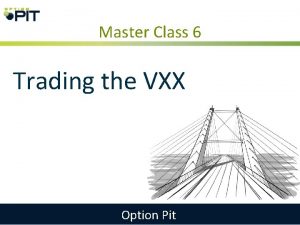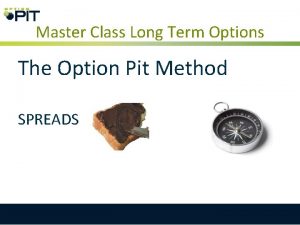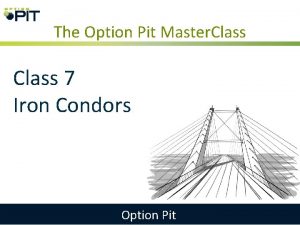The Option Pit Method Option Pit Master Class


























- Slides: 26

The Option Pit Method Option Pit Master Class Using Options in an Equity Portfolio Calls, Puts and Assignment Option Pit

Option Boot Camp- The Option Pit Method - The Option Pit method uses - Position Structure - Efficient use of Capital - Risk Management - Structure positions that have “edge” but keep the risk reward profile reasonable

What you will learn • • • Option Trading and Option Investing Long versus short Long and Short calls and puts Exercise and assignment A short put investment

Risk and Reward (revisited) Risk and reward is sprinkled thorough out the Master Class Tying concepts together are very important I will highlight the flagged concepts Risk, reward, loss and gain will help investors make relative judgements on option and stock trading. As we go through the course try to understand what will make the “best” risk reward setup for a given market condition or idea As in why stock over calls or why puts over short stock?

Option Trading and Option Investing • Many Retail investors confuse the two concepts since it makes a large difference in how to approach options in general – Option Trading expects a close/adjustment for the positon prior to expiration so the trading is short term in nature – Option Investing expects eventual delivery for the position by expiration so the investment is long term in nature • Confusing the concepts leads investors to turn small losses into large losses. Concentrating on the end game focuses the mind for a proper position to suit the task at hand

Arc of the Move (revisited) The Arc of the Move is a catchy title for the straddle value of a given Expiration cycle. It is the market best guess (68. 2 probability) that the underlying will move in that range for the term. Options outside the straddle are less likely to be in the money Options inside the straddle are more likely to be in the money

Long and Short • This is what we call a direction bias for a security • Is the stock, index, commodity, bond going to go up in price or down in price • This is also known as the direction of the underlying security as any option will respond to the price action of this security – Long wants the underlying to go up in price – Short wants the underlying to down in price

What is long and short stock Long is ownership and has rights » The direction bias is up chart » Tick for tick win or loss » Loss is theo 0 Short is borrowing and has obligations » The direction bias is down » Tick for tick win or loss » Loss is Theo unlimited (there is more risk in shorting a stock than owning, remember this when we talk about puts)

How does short stock work? – It must be “located” and borrowed (borrow rate) from an owner » This implies that it can be taken away (short squeeze) » It happens with enough frequency that it can upset option markets » Short stock has an implied risk of being taken away in addition to the direction bias (two risks not 1) • We cover more dynamics in Silver

What is the borrowing rate There is a cost associated with borrowing stocks for retail traders (it is a hassle for the broker dealer but they charge the trader for the hassle) – If the cost gets too high the issue could be “bought in” and the shorts are forced to cover or buy back their shorts – If too many have to do it at once you get a short squeeze – This could lead to a big rally in a stock under forced cover – The formula is C price– Pprice + Strike= Stock Price review this later) ( we

TLRY Call – Put + Strike = Stock 7. 00 – 7. 70 + 65 = 64. 30

Delivery – Delivery of the underlying comes in the form of a security or cash » It is not a reason to panic » Exercise is from ownership (long the contract) » Assignment is from obligation (short the contract) but your risk is actually reduced but margin increases » Know what you are getting • Most equity options deliver stock, most index option deliver cash but check here: http: //www. cboe. com/products/

Delivery- Result – If you have to take the stock, long or short, you need the money (margin). Note the margin of taking the stock is always more than just the call or put. The option has risk to the strike price, stock risk is much greater up or down » Exercise is more risk » Assignment is less risk • When does one take delivery – One takes deliver on expiration for European exercise – One can take delivery any time during the term for American Exercise » There are mathematical rules here

When is something assigned – Generally assignment happens in American Exercise options when the delivery value is more than the option value on other side of the strike. There are several parts: » Cost of carry, dividends and the put value of the strike – Interest rates XRT (think of the cost by your broker for margin) » This is known as cost of carry (strike x rate x time to expiration/360) and this is one side of the equation » Puts are assigned when the cost of carry is larger than the call on the other side of the strike so for very ITM puts (more on this later in the course) – Dividends » Remember this is the cash flow stream • Long calls don’t pay a dividend • Long puts don’t owe a dividend » The rule is simple, if the dividend is worth more than the put on the strike the call will be assigned 99% of the time.

Dividend Assignment Example ITM calls were the put is less than 1. 23 will be assigned The DAY BEFORE EX-DIVIDEND

Expiration and Assignment – There are expirations every week and the contract bought or sold tells you when the expiration is. This is when settlement and delivery happen. • Options settle on the closing price for the contract and all delivery is based on the that price. – When to take assignment/risk it » Short options can be assigned after Fridays close. If the option is close to the strike it can be assigned and the assignment is random. » Only risk assignment if one wants to be assigned (Investment)

Short Calls and puts • How to make money – You want the underlying to move in the right direction or nowhere at all during the term of the option – You can only make what you sell the option for- loosely equivalent to a dividend stream (remember the risk in a dividend paying stock is the cost of the underlying which is a lot) • Short calls want the underlying to go down in price • Short puts want the underlying to go up in price – The risk reward profile is extreme for short options

Value proposition – The risk in the long call versus the margin reduction over stock is the main reason to own a call over stock » Example on 1 call contract » The trick is making sure there is enough time to work it out » Setting loss limits early since the leverage should work in an up move • Small losses are key

Value proposition – Risk reward payout for a round lot of 100 shares and 1 put contract – The premium risk in the long put versus the margin reduction/ short squeeze potential over short stock is the main reason to own a put over short stock » Example on 1 put contract » The trick is making sure there is enough time to work it out » Setting loss limits early since the leverage should work in an up move • Small losses are key

Short Call and Put Comparison Short AAPL Apr 190 call Short AAPL Apr 187. 5 put

Long Call and Put Comparison Short AAPL Apr 190 calls Short AAPL Apr 187. 5 puts

Working out the risk reward • Short Call- selling a 190 call is $4000 in margin to make $400 around 10% for 3. 5 weeks • The ultimate goal is minimize the margin and increase the yield potential • Short Put-selling a 187. 5 put $18750 in margin to make $350 or 2% for 3. 5 weeks

Finding Options in the Market • Walk through the Risk/Reward • Do the hard side first – Getting filled when the market is dropping. » Long direction underlying is easy to fill » Short direction underlying is hard to fill (HARD SIDE) • Reading markets – Size and width – deeper the better as it is a trading zone

Practical Applications

Notes

Send Questions • Send me a note at Andrew@optionpit. com
 Eh option
Eh option Bssd adalah
Bssd adalah Option terminology
Option terminology Prismoidal formula
Prismoidal formula Symposium teaching method
Symposium teaching method Masterclassmanagement
Masterclassmanagement Kubernetes master class
Kubernetes master class Pilate master class
Pilate master class Hình ảnh bộ gõ cơ thể búng tay
Hình ảnh bộ gõ cơ thể búng tay Bổ thể
Bổ thể Tỉ lệ cơ thể trẻ em
Tỉ lệ cơ thể trẻ em Chó sói
Chó sói Glasgow thang điểm
Glasgow thang điểm Bài hát chúa yêu trần thế alleluia
Bài hát chúa yêu trần thế alleluia Môn thể thao bắt đầu bằng từ chạy
Môn thể thao bắt đầu bằng từ chạy Thế nào là hệ số cao nhất
Thế nào là hệ số cao nhất Các châu lục và đại dương trên thế giới
Các châu lục và đại dương trên thế giới Công thức tiính động năng
Công thức tiính động năng Trời xanh đây là của chúng ta thể thơ
Trời xanh đây là của chúng ta thể thơ Cách giải mật thư tọa độ
Cách giải mật thư tọa độ Làm thế nào để 102-1=99
Làm thế nào để 102-1=99 Phản ứng thế ankan
Phản ứng thế ankan Các châu lục và đại dương trên thế giới
Các châu lục và đại dương trên thế giới Thơ thất ngôn tứ tuyệt đường luật
Thơ thất ngôn tứ tuyệt đường luật Quá trình desamine hóa có thể tạo ra
Quá trình desamine hóa có thể tạo ra Một số thể thơ truyền thống
Một số thể thơ truyền thống


























